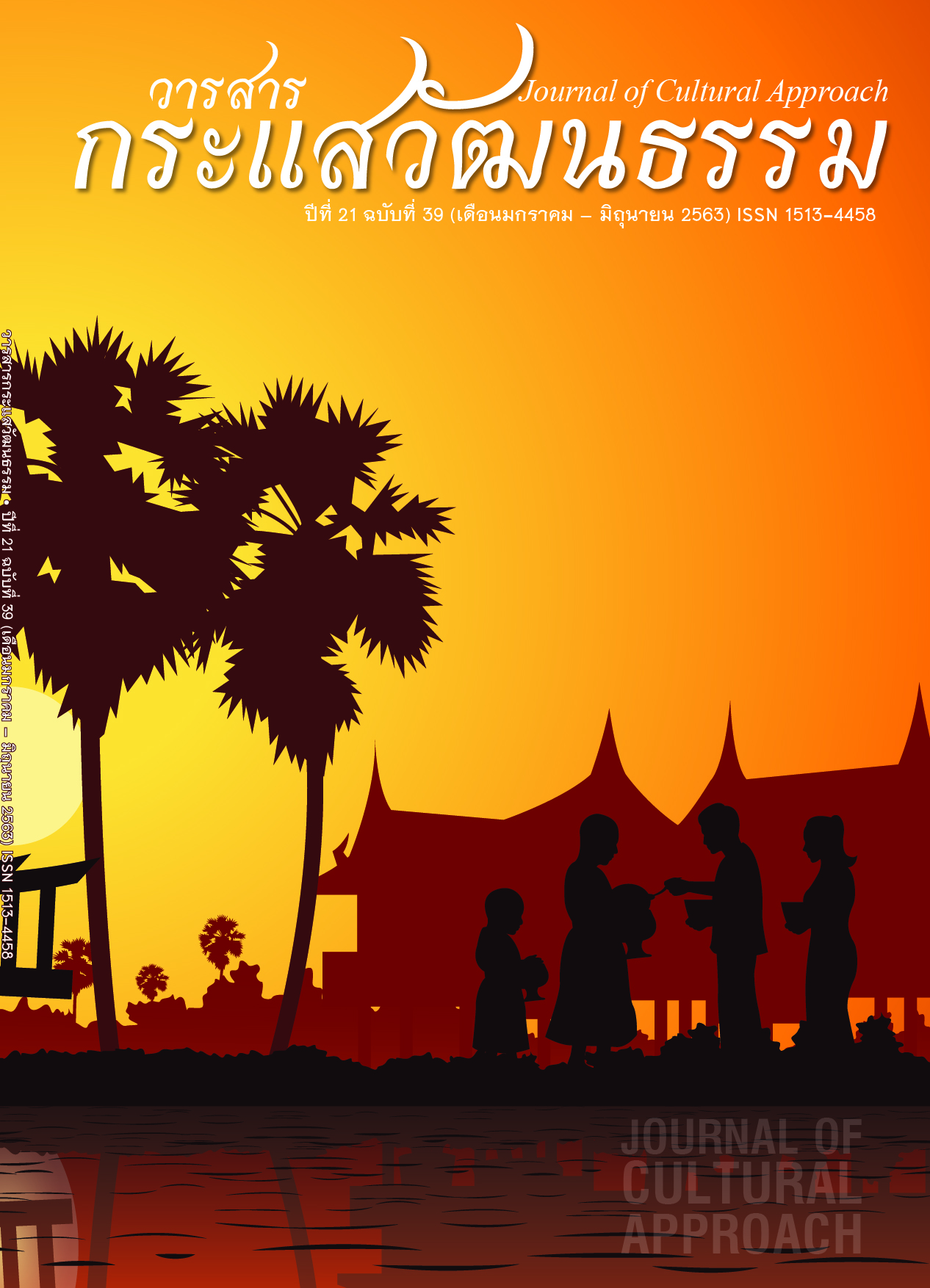A Wooden Clappers in the Music Culture of The Mekong River Region
Main Article Content
Abstract
This research was aimed to: 1) Study historical evidence and records relating to wooden clappers, 2) Identify the roles of wooden clappers in The Mekong River region, and 3) Study musical straits of wooden clappers in the music culture in the Mekong River Region. This qualitative research was in compliance with the musicology discipline. The field information and reviewing of related documents were used primarily as a means of data collection. The research stretched across the cultural homogeneous counties in the Mekong River Region including Thailand, Laos, and Cambodia.
Wooden clappers were found to have a long history of origin as proven by many historical pieces of evidence and records. One of the most outstanding ancient artifacts depicting the origin of the instrument was a cement sculpture from Dvaravati, which was built somewhere between the 13-14th B.E. This ancient artwork shows the time at which wooden clappers have been deployed in musical culture in the region. At present, the wooden clappers exploited in the countries around the Mekong River region still share a lot of identities such as the similarities in physical structure, playing method, rhythm, melody, expression, and songs. The similarities in these areas should be a result of the social, cultural and geographical contacts of the countries in the region. Three types of wooden clappers were observed; 1) tapping clappers, 2) paired clappers, and 3) bell clappers. All of these clappers are used mainly for beat controlling, singing, and performing. Clappers are also used in some rituals, especially in the royal ceremony, as a beat controller. Wooden clappers are used by local music bands that are a common source of entertainment for the local community’s festive ceremonies. Wooden clappers have become less popular and may soon totally disappear in Laos and Cambodia. Amidst cultural diversities in the region, the presence of wooden clappers is evidence of the region’s shared-cultural roots. Wooden clappers should be maintained as valuable local wisdom that lasts alongside the presence of the community.
Article Details
Proposed Creative Commons Copyright Notices
1. Proposed Policy for Journals That Offer Open Access
Authors who publish with this journal agree to the following terms:
- Authors retain copyright and grant the journal right of first publication with the work simultaneously licensed under a Creative Commons Attribution License that allows others to share the work with an acknowledgement of the work's authorship and initial publication in this journal.
- Authors are able to enter into separate, additional contractual arrangements for the non-exclusive distribution of the journal's published version of the work (e.g., post it to an institutional repository or publish it in a book), with an acknowledgement of its initial publication in this journal.
- Authors are permitted and encouraged to post their work online (e.g., in institutional repositories or on their website) prior to and during the submission process, as it can lead to productive exchanges, as well as earlier and greater citation of published work (See The Effect of Open Access).
Proposed Policy for Journals That Offer Delayed Open Access
Authors who publish with this journal agree to the following terms:
- Authors retain copyright and grant the journal right of first publication, with the work [SPECIFY PERIOD OF TIME] after publication simultaneously licensed under a Creative Commons Attribution License that allows others to share the work with an acknowledgement of the work's authorship and initial publication in this journal.
- Authors are able to enter into separate, additional contractual arrangements for the non-exclusive distribution of the journal's published version of the work (e.g., post it to an institutional repository or publish it in a book), with an acknowledgement of its initial publication in this journal.
- Authors are permitted and encouraged to post their work online (e.g., in institutional repositories or on their website) prior to and during the submission process, as it can lead to productive exchanges, as well as earlier and greater citation of published work (See The Effect of Open Access).
References
Fine Arts Department. (1915). Thai Ramayana Written by King Rama I. 9th ed. Nonthaburi: Vajirayana Digital Library. (in Thai)
Fine Arts Department. (1929). Writing by the King: Lakhon Nok of Sang Thong Episode 6 Sang Thong Gets Love from Rojana. Nonthaburi: Vajirayana Digital Library. (in Thai)
Fine Arts Department. (1934). Royal Chronicles King Rama IV of Rattanakosin, 1851– 2411. No. Chaophraya Thiphakorawong (Kham Bunnag). Printed as a Memorial in the Cremation Ceremony Khunying Thammasarn Neti (Ob Bunnag). Nonthaburi: Vajirayana Digital Library. (in Thai)
Fine Arts Department. (2012). Transcription Traiphum (Chapter 5 Human Land) of the ASEAN Literature Project. 2nd ed. In An Academic Seminar on Traiphum Ideology: Influence on Thai Society. Nonthaburi: Vajirayana Digital Library. (in Thai)
Malm, W. P. (1977). Music Cultures of Pacific, the Near East, and Asia. Englewood Cliffs. New Jersey: Prentice–Hall. Inc.
Narathip Praphanphong. (1962). La Loubere are Archives in the Days of King Narai: the Great or Ramathibodi III of Ayutthaya. Volume 1. No. Translated from English to Thai by Krom Phra Narathip Praphanphong in 1914. Bangkok: Kuru Sapa Business Organization Press.
Narong Khianthongkul. (n.d.). Thai Studies (Thai Music). Teaching Documents. Faculty of Humanities, Kasetsart University.
Theraphat Chaiphiphat. (2008). Society and Culture of Countries in the Mekong Sub–Region. Bangkok: Mr.Copy Press.
Yos Santasombat. (2009). River of Life. Faculty of Social Sciences, Chiang Mai University.


